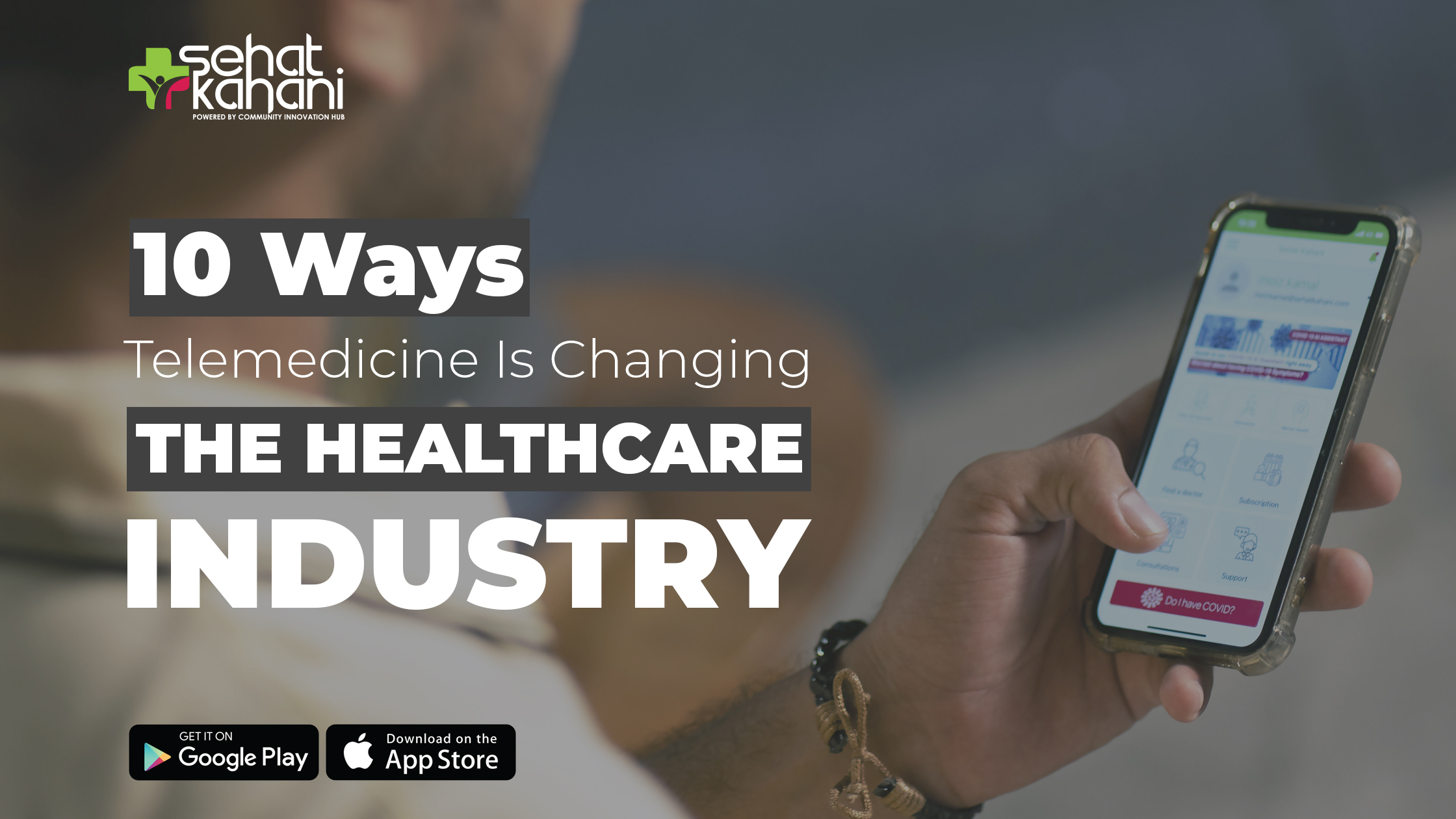
Introduction
People of the 21st century are more and more drawn toward the automation and digitalization of everyday tasks and duties. In the past few years, the concept of online shopping and ordering-in has increased to a great extent. Today, you can not only shop online but can also order services including a spa, cleaning help, and even healthcare services online.
This blog contains a brief account of what telemedicine is and what are the benefits of telemedicine in healthcare. The blog majorly revolves around the ways telemedicine is changing the healthcare industry.
Telemedicine in Healthcare
Telemedicine allows phone or video consultations between a patient and their doctor. The concept of telemedicine in Pakistan also prevailed during the pandemic. More medical professionals now offer to “see” patients over a computer or smartphone.
There are numerous benefits of telemedicine in health care. When you’re ill, telemedicine eliminates the need for you to drive to the doctor’s office or clinic, or wait in a waiting area. You can visit your doctor while relaxing on your sofa or bed at home. Telemedicine is also becoming the choice of many people for the healthcare management of long-termed diseases.
Ways Telemedicine Is Changing the Healthcare Industry
Modern technologies are transforming everything for good. The main aims of these innovations are to cut costs, save time, and improve convenience. Following are the 10 ways telemedicine is changing the healthcare industry;
1. Effective long-termed care
Maintaining a safe social distance is made easier by telemedicine, which can offer long-term care and treatment for persons with chronic diseases via an online application or other telecommunication technology. Various chronic heart diseases and digestive disorders can be managed using telemedicine. Common telemedicine techniques include telemedicine consultation and telemonitoring. This allows the doctors to manage the symptoms, check the efficacy of the current treatment, and make effective alterations in the ongoing treatment.
Telemedicine consultations provide patients with the latest medical treatment they require. The majority of the time, patients are happy with the service as they can decide when to schedule consultations. Telemonitoring lowers the number of visits and hospital admissions, allowing for more efficient use of limited medical resources.
2. Increased privacy
Since patients don’t have to visit hospitals and doctors in person using telemedicine, their visits can stay private. This enables people to get treatment for the diseases or conditions they are somewhat shy to consult for. For example, women of Pakistan face a lot of challenges when it comes to the treatment of PCOS or any other reproductive or sexual disorder. With telemedicine, these women can consult their doctors online in the privacy of their homes which ensures that they get proper and timely treatment and their health is not affected by socio-cultural taboos or general shyness.
3. Cost reduction
Telemedicine causes cost reduction for both patients and doctors. The seemingly expansive consultation costs of telemedicine can still facilitate cost reduction due to many reasons. The most significant cost reduction is the elimination of travel. Considering the increasing rates of fuel, arranging an online visit cuts the travel cost for both the doctor and the patients. This cost reduction can be noteworthy for people with chronic diseases who require regular visits as they are already under a lot of financial strain due to their condition. Today, various insurance companies are creating partnerships with telemedicine platforms. This cover the expanses of virtual care visits, which can also reduce the costs of healthcare.
4. Convenient access to healthcare
Healthcare visits can cost both time and money. Working communities or even students have to take a day off from their work or educational institutes to schedule an in-person consultation. Whereas, an online consultation can be arranged and conducted from the comfort of your home. There are usually various slots available from which you can choose, according to your availability. And even if the consultation is scheduled during your work hours, you just need a quiet place with your phone to attend it rather than taking the whole day off.
People having the responsibility of the child or elderly care can also benefit from telemedicine. You can attend your online consultation without having to hire care for your child or elderly. Telemedicine is highly convenient for the treatment of elderly with mobility issues as well. Children tend to be uncomfortable in places they are unfamiliar with. Since online consultations are from home, children are calmer there and can be treated better.
5. Assists ICU multidisciplinary staff
The patients in ICU require non-stop care. There should be specialists available all the time as the situation of critically ill patients can change anytime. Sometimes it is not possible to have all the specialists available on time especially if the admitted patient has a variety of problems. In this case, telemedicine can help. It allows specialists to provide care for their ICU patients remotely and give immediate medical advice according to the condition of the patients.
The tele-ICU serves as a “second set of eyes” for nurses and doctors who must treat multiple patients at once while contending with alarms and other distractions that could cause them to overlook a medication dose, a sudden change in blood pressure, or other critical signals.
Professionals of the tele-ICU use one- or two-way cameras to perform bedside assessments or consult with doctors. They have the same access to patient data as on-site critical care staff, including vital signs, lab findings, and doctor’s notes. Remote doctors may more closely monitor a patient’s development and provide alternative treatments or medications because they aren’t as distracted as those in the hospital.
6. Facilitate at-home rehab and physical therapy
The treatment process just gets started when patients are released from the ER or the ICU. Patients who are recovering from a stroke or dealing with another neurological condition like multiple sclerosis, Parkinson’s disease, or dementia should be especially aware of this. Whether they live in an urban or rural area, these patients frequently find it challenging to commute to a medical institution.
The use of telemedicine in rehabilitation addresses these issues in several ways, including conducting cognitive or psychiatric evaluations, facilitating group therapy sessions, giving patients access to online resources, and remotely checking patient’s pedometer readings to make sure an exercise regimen is up to par.
7. Immediate treatment for strokes and heart attacks
A heart attack or stroke victim’s chance of survival increases with the speed at which they receive care. The ability to recognize important signs and deliver the medication within three to five hours of experiencing a stroke or a heart attack is crucial for many cases of treatment. Sadly, not all emergency room doctors are qualified to make these choices. To mitigate this problem, telemedicine can be used. Telemedicine ensures immediate first aid to the victims of stroke and heart attacks which can save lives.
8. Helps in the management of heart diseases and diabetes
Globally, cardiovascular illnesses are the number one cause of death. Whereas, 1 in 8 adults which makes up to 206 million people of the current population are living with diabetes. Many life-threatening cases can be avoided with the aid of drug therapies or social or lifestyle modifications. Making regular hospital visits can be challenging, but patients must work closely with their doctors to give up smoking, lose weight, adjust their diet, improve glycemic control or start an exercise regimen. Telemedicine technology may offer a solution to manage diabetes and heart diseases.
There are two requirements for the successful management of diabetes and heart diseases. To improve glycemic control, a patient’s relationship with a doctor must first increase self-efficacy or the conviction that such activity is, in fact, possible. Second, treatment programs must include objectives for successfully altering patient behavior. This is made easier by telemedicine, which enables patients to track their vital signs, document their exercises, track their calorie intake, and keep track of their medication dosages and schedules.
9. Expanded medical network
Through telemedicine, patients can receive care from a doctor who practices anywhere in the world. Doctors might also consult with their peers about a patient’s condition to determine the best course of action. Using telemedicine, you don’t have to choose the doctor who is the nearest to you, rather can choose who is the best for you.
10. Reduction in total hospital expenses
The capacity of hospitals and clinics to automate administrative tasks and other manual operations is one of the most significant features of telemedicine. This decreases the cost for the hospital as they make the most of the workforce they already have. Telehealth can aid in better resource management by reducing employee responsibilities and giving them the tools they need to be successful in other areas of their professions.
Online consultations don’t need an office which eliminates the expenses of office rent and maintenance. Hospitals can reduce office workloads and lower overall medical expenditures if they can transfer patients who don’t require inpatient care to remote care.
Conclusion
In this digital age, telemedicine is changing the healthcare industry at a very fast pace. It has amplified convenience, improved long-termed care, enabled immediate treatment, and many more. It is expected that this field will grow more in the future with the advancements in telecommunications, artificial intelligence, and technology and will transform healthcare for good.



